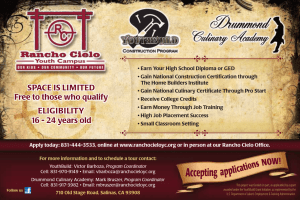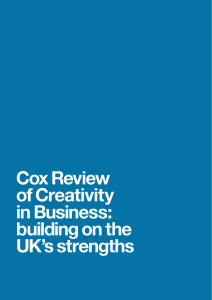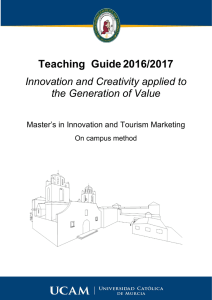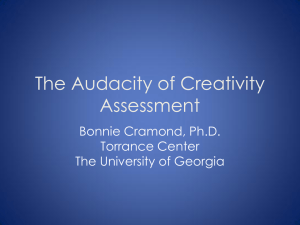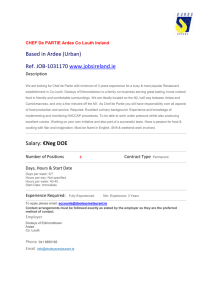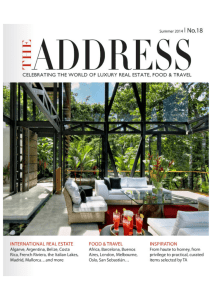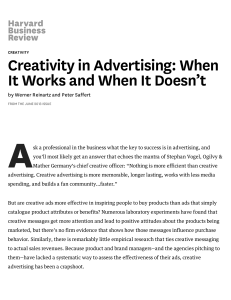A PATH MODEL OF THE CREATIVITY PROCESS AND OF CULINARY PERFORMANCE
Anuncio
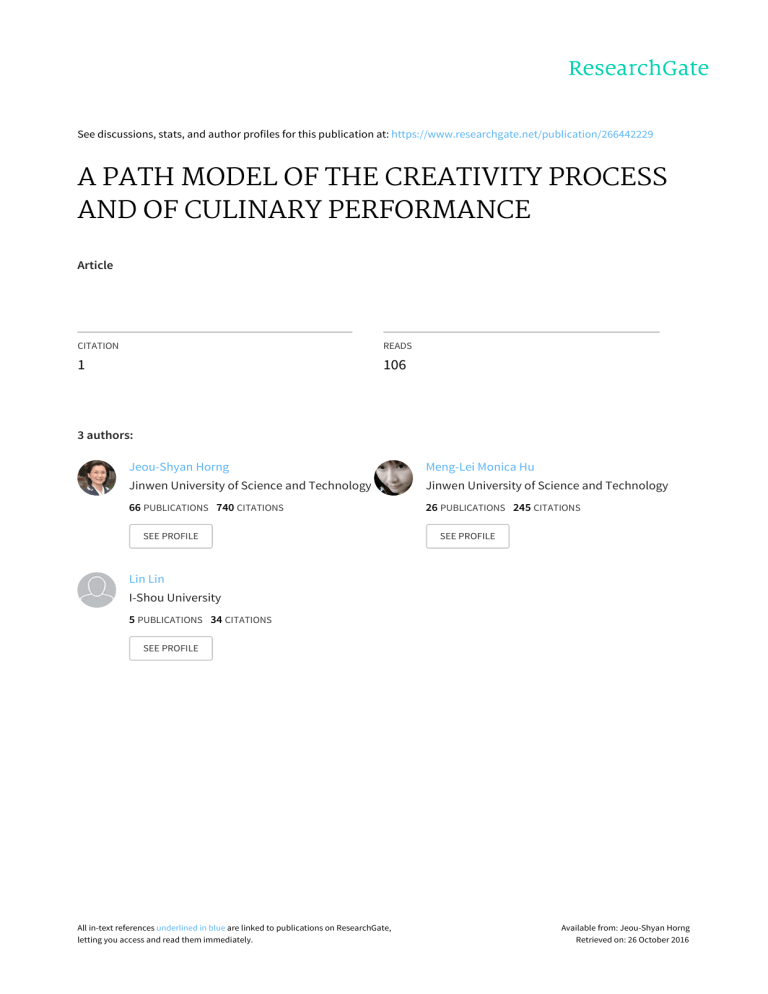
See discussions, stats, and author profiles for this publication at: https://www.researchgate.net/publication/266442229 A PATH MODEL OF THE CREATIVITY PROCESS AND OF CULINARY PERFORMANCE Article CITATION READS 1 106 3 authors: Jeou-Shyan Horng Meng-Lei Monica Hu Jinwen University of Science and Technology Jinwen University of Science and Technology 66 PUBLICATIONS 740 CITATIONS 26 PUBLICATIONS 245 CITATIONS SEE PROFILE SEE PROFILE Lin Lin I-Shou University 5 PUBLICATIONS 34 CITATIONS SEE PROFILE All in-text references underlined in blue are linked to publications on ResearchGate, letting you access and read them immediately. Available from: Jeou-Shyan Horng Retrieved on: 26 October 2016 A PATH MODEL OF THE CREATIVITY PROCESS AND OF CULINARY PERFORMANCE Jeou-Shyan Horng National Taiwan Normal University Dept of Human Development & Family Studies Division of Hospitality Management & Education Taipei, Taiwan e-mail: [email protected] Meng-Lei Monica Hu Jinwen University Science and Technology Food and Beverage Management Taipei, Taiwan e-mail: [email protected] Lin Lin National Taiwan Normal University Dept of Human Development & Family Studies Taipei, Taiwan e-mail: [email protected] ABSTRACT A path model of both the creative culinary process and culinary performance was developed by means of a qualitative study and self-administered questionnaires. This model conceptualizes the influence on culinary performance—on the actual making of new dishes—of idea preparation, idea incubation, idea development, and verification of the new work’s creativity. A structural equation was applied to the data obtained through the questionnaire in order to test the proposed model. Direct relationships were found to exist between the four phases of the culinary creative process and the creative performance of chefs. The results of this study have clear implications for the promotion of creativity on the part of culinary artists, and therefore for educators and managers in the culinary and hospitality (hotel and restaurant) fields. Key Words: idea, creativity process, culinary performance. INTRODUCTION Many countries, among them Hong Kong, Turkey, and France, attract big-spending tourists with their unique cuisine. The issue of culinary creativity has thus become increasingly important in the context of the tourist industry and national economies. Culinary artists are now expected to assume the roles of laborer, professional and businessperson as well as that of creative innovator. Nonetheless, creativity remains an important factor, and in recent creativity research the creative process has been especially emphasized (Mace and Ward, 2002). In fact, however, at least in the hospitality (hotel and restaurant) industry, the actual process of creativity (the creation of new dishes, new culinary “works”) remains somewhat ambiguous. Traditional research, particularly before the 20th century, tended to define creativity only as an outcome or result, the finished product that results from the artist’s new idea(s). Yet clearly it is crucial to understand the way in which individuals come to develop creative ideas. The creative process itself – the sequence of thoughts and actions that lead to a novel production, one that is still adapted to the context and to certain pre-existing conditions – became an important focus of creativity research in the 20th century. Some theories have suggested that the creative process involves several stages, including identifying a problem, gathering information, generating ideas, and evaluating, modifying, and communicating ideas (Amabile, 1996; Mace and Ward, 2002). Most research on the creativity process has focused on just a few cognitive processes, and on the skills involved in creative problem-solving. Some recent empirical research focuses on employees’ engagement in creative processes at work (Gilson and Shalley, 2004). Yet there has been little direct empirical analysis of the content of creativity processes. This study seeks, then, to explore the relationship between the culinary creativity process and the “performance” of the culinary artist, where the latter refers to “what can be seen,” the artist’s actions and final product. The only qualitative study to date of the process of culinary creativity (Horng and Hu, 2006) found that this process includes four phases. Together, they form a dynamic cycle: preparing the idea, idea incubation, idea development, and “verification” of the culinary creation. The present study expands upon Wallas’ (1926) and Horng and Hu’s (2006) research to present a conceptual framework for both the culinary creativity process and culinary performance. The phases of the culinary process are here taken to be, again, idea preparation, idea incubation, idea development, and verification of the culinary artwork. Hypotheses are tested on the basis of empirical data drawn from this four-phase process, a self-assessment questionnaire regarding the performance of culinary artists, and culinary competition records. LITERATURE REVIEW The model presented in Figure 1 assumes that the process of culinary creativity positively influences culinary performance in a cumulative fashion. Thus, for instance, “preparing the idea” subsequently impacts on “idea incubation,” “idea development” and “verification,” and these have a cumulative influence on culinary performance. A description of this model’s variables is presented below, along with a description of their hypothetical inter-relationships. Creativity process Preparing Idea Idea Verification of Culinary new ideas incubation development culinary work performance Figure 1 Model of culinary creativity process and performance Although culinary artists (chefs) and educators have long understood the importance of culinary creativity, there was still a mystery to it (Horng and Lee, 2006). Professional cooks seem to have been ignored for a long time because of the culturally-influenced approach proposed by Amabile (1996). In the French culinary tradition, creativity is the refinement of classical or traditional culinary arts, and the “professional” or “business” side of the culinary arts is de-emphasized. However, clearly culinary arts have a professional (in the sense of money-making) as well as purely artistic side to them. Furthermore, while top chefs do need to know classical arts in order to refine them, in fact top chefs are also always exploring radically new ideas, not only those based on tradition. These new ideas come in part from the everyday world around us and from constant experimentation. Therefore, the key problem is to understand the various ways in which the chef’s or culinary artist’s new (creative) idea may be generate (Drazin et al., 1999). Several researchers have focused on the central role of having a “problem” to solve; for instance, on the process of “identifying” and then “considering” and finally “redefining” that problem (Lubart, 2001). In fact Wallas (1926) was the first to propose the four phases of the creativity process: preparation phase, incubation phase, inspiration phase, and evaluation phase. Although many researchers have lent support to this four-stage model, it has also received much criticism. Guilford (1950, p. 451), for example, while noting that there was “a considerable agreement that the complete creative act involves four important steps,” was not satisfied with Wallas’ four-stage description of the creative process. He thought that “such an analysis was very superficial from the psychological point of view. It tells us almost nothing about the mental operations that actually occur.” Nonetheless, this four-stage model is still considered the basic framework for analyzing creativity in cognitive and organizational psychology. Amabile (1996) proposed the following four stages based on Wallas (1926) research: (1) identifying a problem; (2) collecting and filtering usable information and resources; (3) creating feedback; (4) effective feedback and communication: reviewing possible feedback. In this cyclic model each stage can be indefinitely repeated. Before Amabile, Finke et al. (1992) had already proposed the Geneplore model, which provided a basic structure for the cognitive process and explained the phenomena of creative cognition. This model consisted of two distinct processing components: generative processes, followed by exploratory ones. In the generative phase, one constructs mental representations called pre-inventive structures with various properties that promote creative discovery. Generative processes, such as retrieval, association, mental synthesis, mental transformation, and analogical transfer, give rise to pre-inventive structures; the latter may consist of mental images, verbal combinations, category exemplars or purely mental models. These structures are then explored in order to assess their creative possibilities. These pre-inventive structures can be thought of as internal precursors to the final, externalized creative products and may be generated, regenerated, and modified throughout the course of an artist’s creative exploration. These exploratory processes include attribute finding, conceptual interpretation, functional inference, hypothesis testing, and searching for limitations. Once these exploratory processes are completed, the pre-inventive structure can be refined or regenerated, depending on what one discovers during the exploratory phase. This cycle, moving as it does through the phases of generation and exploration, typically occurs when people engage in creative thinking. For example, a person may retrieve two mental images and combine them in the generation phase to produce a visually interesting form, and then interpret this form in terms of new ideas. The cycle can then be repeated until the structure has been developed to the desired extent. Further examination of the form may lead to the conclusion that it is incomplete in some respects. A modified form is then generated by retrieving yet another image and mentally combining it with the already existing one. The Geneplore model also considers constraints on the creative product and how they affect the underlying cognitive processes. After a consideration of the various models briefly summarized above, this researcher has decided to keep the “classical” model of Wallas, as modified by Amabile, Finke et al. Thus the present study assumes that: Hypothesis 1: There are four phases in the culinary creativity process: an idea preparation phase, idea incubation phase, inspiration phase and product evaluation phase. Furthermore, this study assumes that after first collecting various forms of information as preparation for the new “idea,” the culinary artist enters the stage of idea incubation, which includes idea selection, analogical transfer and categorical reduction, as well as synthesis and transformation. The third phase is then the idea development phase, which includes finding attributes, conceptual interpretation, functional inference, context shifting, discussion and compromise, and illumination. The final phase is the “verification” of the culinary work. In this phase, the culinary artist may evaluate and conduct hypothesis testing with regard to the culinary product he has created. Influenced by Amabile and Finke among others, this study also assumes that: Hypothesis 2: There will be positive relationships and effects between and among the sub-processes (the four phases) of the culinary creativity process. And finally, of course, it also assumes that: Hypothesis 3: The entire creative culinary process has a positive impact on the performance of the culinary artist. METHOD The research is mainly divided into two sections. First, using a qualitative research method, including in-depth interviews with creative culinary artists, the phases and structure of the culinary process model design were developed. Second, quantitative data were collected by questionnaires in order to perform a cross-sectional study of the culinary artist sample. Section one: By employing a qualitative approach, the researcher interviewed 17 award-wining culinary artists, analyzed their interview transcripts as well as other relevant documents, and used grounded theory to interpret their creative process. The core elements of the creative culinary process were then specified through the techniques of repetitive reading, conceptualization, coding and reduction. These essential elements include idea preparation, idea incubation, idea development and verification of the artwork. Section two: Base on the results of qualitative study, a questionnaire containing 47 criteria was created for the pretest. In addition, participants were requested to specify their gender, age, educational background, job, specialty, working experience, and evaluation of their own creativity (“self-evaluation”). We used 3 items that were self-developed to measure self-reported culinary creativity performance. For each criterion on the questionnaire, respondents assessed the degree of their agreement with statements on a 6-point Likert-type scale. The participants selected by the pre-test and final survey through purpose sampling were chefs and students who have not only had experience as contestants in culinary competitions but have been very successful in those competitions. Creativity has indeed become an important criterion in major competitions, so award-winners must be able to be as creative as possible, even when relying on their standard techniques. Those taking the pre-test and final survey included both Chinese- and Western-cuisine chefs and students with hands-on cooking experience, and they could be divided into two categories: award-winners in international culinary contests within the last 10 years, and winners in both international and domestic culinary competitions. The international competitions include those held in Singapore and Taipei, the Work Skills Competition and the Bocuse d'Or World Cuisine Competition. A pre-test was administered to select the most creative and successful chefs, to whom we then distribute questionnaires. Respondents were volunteers and were required to give consent to the interview in writing. One hundred and thirty questionnaires were distributed and 102 were returned. The response rate after deducting the unusable questionnaires was 78.40%. Items were revised for the final survey after taking into account the feedback from the preliminary data analysis results of the pilot questionnaire. The survey was subsequently distributed to 1,000 participants. In total, 669 usable responses were collected; the response rate after deducting the unusable questionnaires was 66.90%. RESULTS Result of the qualitative method showed that the creative culinary process was analyzed into 4-stage creative process model. We developed 47 items and after conducting an item analysis, we deleted 7 items from the original instrument as a result of the qualitative study of section one. Factor analysis of the 40 items composing the five scales rated by the participants was conducted using principal-component analysis. This procedure produced five factors, and almost every item was loaded with a factor loading of between .61 and .92 and always within the 61.9% explained variance. This structure indicated that the four scales derived from the responses of the culinary artists were empirically distinct, and that the mixing due to common method variance was not significant in the context of our research goals. Of the 669 participants, over half (69.9%) were male and 29.6% were female; 43.3% were between the ages of 21 and 30; 35.9% of them had a high school degree, and 31.8 % had a college degree; half of the participants were chefs: 56.2% of these were Chinese cuisine chefs, and 20.8% were western cuisine chefs. 62.9% of the participants had less than 10 years of working experience, 15.8% had more than 41 years of working experience, and 14.2% had from 11 to 20 years of working experience. Table 1 shows the means, standard deviations, and inter-correlations between and among the variables. All predictors and outcome variables in this study were based on self-reported data. To examine whether common method variance was a substantial threat to the present study, Harman’s one-factor test was performed (Podsakoff and Organ, 1986). The framework in Figure 1 and the hypotheses advanced here were tested by confirmatory structural equation modeling (SEM) analysis using the LISREL program. SEM analysis can measure the appropriate relative impact of multiple predictors on multiple outcomes that are linked by more than two causal steps, controlling for measurement error. We first present the measurement model and then the structural model. Because the creativity process measures used in the present study were newly developed, it was necessary to first investigate if the items measure the hypothesized dimensions and if the hypothesized dimensions are empirically differentiable. Confirmatory factor analysis (CFA) was applied to test the unidimensionality of the scales, using the LISREL 8.5 (Jöreskog and Sörbom, 1996). The CFA model was developed in several steps, with the purposes of testing whether the hypothesized latent variables could be identified empirically, of investigating the measurement characteristics of single items, and of reducing the total number of items. Having established an adequate measurement model, the next step of the procedure involved testing the hypotheses of the study through fitting path models for the relations among the latent variables. These tests involved comparison with the unconstrained CFA model, to test whether models with a hypothesized causal ordering among the latent variable reproduced the unconstrained covariance matrix for the latent variable. Alternative models were also evaluated with respect to model fit and interpretability. For the final structural model, the total effect of each latent independent variable on each latent-dependent variable was decomposed into direct and indirect effects. This is because interpretations that only focus on direct effects expressed by the parameter estimates of the relations between variables in a path model will typically produce incorrect conclusions. Table 1. Means, standard deviations, and intercorrelations among variables Variable Mean SD 1 2 3 4 1.Idea preparation 4.343 0.792 ( 0.889) 2.Idea incubation 4.490 0.705 0.710*** (0.848 ) 3.Idea development 4.427 0.691 0.763*** 0.855*** (0.940 ) 4.Verification of culinary 4.525 0.745 0.693*** 0.828*** 0.845*** (0.831 ) 5.Self-reported creativity 3.905 0.745 0.254*** 0.246*** 0.261*** 0.222*** 5 (0.944 ) N=669. Values in parentheses are Cronbach α’s The CFA model was developed in several steps, in order to (1) test whether the hypothesized latent variables could be identified empirically; (2) investigate the measurement characteristics of single items; and (3) reduce the total number of items. Through successive testing and modification of different models for the same data, different sets of variables were combined into the final model. The final CFA model, then, had an χ2 value of 945.32, df = 737 (P = 0.00). The RMSEA index was 0.049 for this model, with a 90% confidence interval between 0.047 and 0.063; this indicates an acceptable fit of model to data. Other indices of fit also showed it to be acceptable (χ2/df = 1.28, GFI = 0.90, AGFI = 0.81, CFI = 0.95, IFI = 0.95, NFI = 0.94). Out of the 47 items in the instrument, 40 items were included in the final model, which comprised 4 latent variables: these were labeled as idea preparation, idea incubation, idea development, and verification of the creative culinary artwork. Standardized factor loadings, along with descriptive data for each item, are reported in Table 2. Eight items measured the idea preparation factor. Eight items with the loadings (0.63-0.91) asked about “preparing information” and “idea finding’’. The highest loadings (0.91) were observed for the items that asked “I use new ways to connect old ideas or experience to create new work.” The lowest loading (0.63) was asked about “I will photograph or record successful artworks for analysis.“ The idea incubation factor was related to nine items. The highest loadings (0.72) were observed for the items that asked “A decision is made with thorough consideration.” The lowest loading (0.59) was asked about “When an idea can’t be implemented, I will put it aside while keep seeking other possibilities.“ Eighteen items with the loadings (0.58-0.75) measured the idea development factor; ten items that asked about “inspiration;” five items that asked “concretization;” and three items that asked “discussion & compromise.” Five items measured the idea evaluation factor; all item had substantial loadings (0.61-0.72) on the factor. The item with the highest loading was asked about “When an idea is generated, I will implement it after thorough evaluation,” and the lowest loadings were asked: ”I will find the most plausible idea among others.” Table 2. Means, standard deviations, and factor loadings for the items Item Idea preparation 1.I will categorize new ideas and data 2.I will photograph or otherwise record successful artworks for analysis 3. I will photograph/record unsuccessful artworks for analysis 4.When discovering an idea, I will collect more information 5.I will collect data through reading 6.Finding unique foods or recipes helps me discover new ideas 7.Watching culinary contests helps with idea generation 10.I use new ways to connect old ideas/experiences to create new works Idea incubation 11. Different concepts come to me before an idea is generated 12. I look at the same thing from different perspectives 13. I combine different ideas for greater creativity 16. If an idea is not good enough, I will seek a new one instead 17. When an idea can’t be implemented, I will put it aside and keep seeking other 34. A decision is made only afte Mean SD factor loading 4.239 4.123 3.992 4.351 4.494 4.468 4.583 4.494 1.133 1.066 1.119 1.014 1.054 1.034 1.072 0.971 .67 .63 .64 .64 .67 .74 .85 .91 4.549 4.460 4.527 4.464 4.370 1.472 0.922 0.948 0.984 1.004 .63 .69 .67 .61 .59 Table 3 Effect decomposition for the path model Independent variable/dependent variables Preparing the idea /idea incubation /idea development /verification of culinary work /creativity performance idea incubation /idea development /verification of culinary work /creativity performance idea development /verification of culinary work /creativity performance verification of culinary work /creativity performance Direct Effect (β) Indirect Total 0.92** ---- -0.83** 0.77** 0.25* 0.92** 0.83** 0.77** 0.25* 0.90** --- -0.84** 0.27* 0.90** 0.84** 0.27* 0.93** __ -0.30* 0.93** 0.30* 0.32* -- 0.32* Note: n = 669. * P < 0.05, ** P < 0.01 level. CONCLUSION AND DISCUSSION The findings of this study suggested that there are four phases in the process of culinary creativity, which as sub-processes have a direct positive effect on one another and on the over-all process, and which also have (or at least the last of which has) a direct positive impact on the culinary artist’s creative performance. Theories of the creative process will still need to specify in much greater detail how these phases or sub-processes can be sequenced to yield optimal creative performances. Here we need to keep in mind the fact that while it may be evaluation of the product which most directly influences performance, evaluation is closely bound up in a pattern of cyclic interactions, as Finke et al’s Geneplore model makes clear, with the other three phases or sub-process of the four-phase creative process model. This path model of culinary creativity and creative performance is an empirical model, and as such can provide an empirical analysis of the culinary creativity process. The model demonstrates that creativity takes place over a period of time rather than being actualized at a single point in time. And this creative process moves through a series of phases or sub-processes, each of which individually and all of which together, in their cumulative interaction, contribute to the development or creation of the culinary artwork. The fact that there may also be a repetition of the various phases is also significant, inasmuch as it implies that culinary artists may modify works which they have created (as their “performance”) in the first run-through of the creative process, by returning to earlier phases (idea preparation, incubation, inspiration) and coming up with new ideas that they now can combine with the work being modified. This sort of creative “recycling”—through which we take what we want and discard what we do not want—can in theory be repeated an indefinite number of times. However, it was also found that the direct “effect” of the whole four-phase creative process on the artist’s creative performance, even including the effect of the fourth phase (evaluation of the work being produced), was limited to 32%. This suggests that there are other factors besides culinary creativity (or the process of culinary creativity) which contribute to or impact on the culinary artist’s performance. Still, the creative process is clearly an important factor; indeed, without this process culinary works could hardly be produced. Thus, once again, the path model of the creative culinary process and performance will be a very useful one for chefs, educators, managers and other professionals in the culinary and hospitality fields not just to keep in mind but to make use of and to further explore and develop. REFERENCES Amabile, T. M. (1996). Creativity in Context. Boulder, CO: Westview. Drazin, R., Glynn, M., & Kazanjian, R. (1999). Multilevel theorizing about creativity in organizations: A sense-making perspective. Academy of Management Review, 24: 286-307. Gazzoli, J. J. (1995). The recipe for “three star” management success. Trusts & Estates, 134(12): 8-14. Gilson, L. L., & Shalley, C. E. (2004). A little creativity goes a long way: An examination of teams' engagement in creative processes. Journal of Management, 30(4): 453-470. Guilford, J. P. (1950). Creativity. American Psychologist, 5: 444-454. Hair, J. F., Anderson, R. E., Tatham, R. L. and Black, W. C. (1998). Multivariate Data Analysis. NY: Macmillan Publishing Company. Horng, J. S. and Hu, M. L. (2006).The Mystery in the kitchen: The developmental process of culinary creativity. The R&D Management conference 2006, Taiwan. Horng, J. S. & Lee, Y. C. (2006). What does it take to be a creative culinary artist? Journal of Culinary Science and Technology, 5(2/3), 5-22. Jöreskog, K. and Sörbom, D. (1996). LISREL 8 User’s Reference Guide. Chicago, IL: Scientific Software International. Lubart, T. I. (2001). Models of the creative process: Past, Present and Future. Creativity Research Journal, 13(3/4), 195-308. Mace, M. A., & Ward, T. (2002). Modeling the creative process: A grounded theory analysis of creativity in the domain of art making. Creativity Research Journal, 14(2): 179-192. Pedhazur, E. J. (1982). Multiple regression in behavioral research: Explanation and prediction. Holt, Rinehart and Winston, Fort Worth, TX. Podsakoff, P. M. and Organ, D. W. (1986). Self-reports in organizational research: Problems and prospects. Journal of Management, 12: 531-544. Wallas, G. (1926). The art of thought. New York: Harcourt Brace. Weisberg, R. W. (1993). Creativity: Beyond the myth of genius. New York: Freeman.
